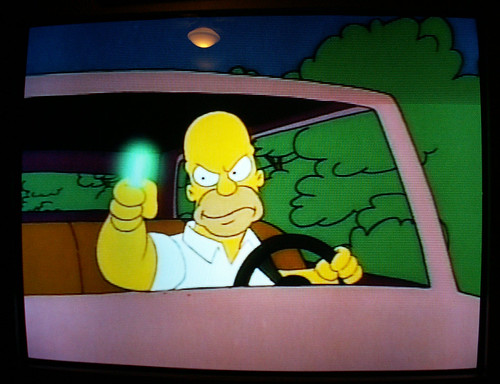
I have been having the following conversation with another blogger, and while most of it has been taking place in the "comments" part of my Mother's Day entry, I would like to bring it to the front. Go back and read the original entry, and then read the comments. And here is my response to his final comment.
You. Did. NOT. Just. Suggest. Nuclear. Power. Ozarkyn, are you NUTS?? Really, how can you POSSIBLY think that this is a good idea? Oh yeah, it has no impact on the environment, except for the wastes and danger that it inherently brings to everyone, from the uranium mining to the waste at the end of the cycle. Not to MENTION the accidents that DO happen. Yeah, it's really safe, except for the parts that aren't. You can't explain these problems away. My sources aren't from some left-wing nutjobs. Look at the references at the end of these articles. They're well-respected journals.
I do agree that a change in infrastructure is in order. But as I said before, more research is needed. Research to prove to people who believe otherwise that there is a problem (like you!). Lots of them. Research to give viable options. Research to learn how to even approach the problem.
Nuclear power is not the answer. At least, not to the question we're asking. (If the question is, how does Springfield get its power? Then the answer is nuclear power.)

From I,Puzzled's photo on Flickr: The Conundrum of Nuclear Waste Disposal


7 comments:
Yes. I. Did. The amount of waste produced per unit of power made available far exceeds the damage and impact that our other sources of energy yield. It would be great if we could solve the containment and heat issues of fusion, but even fission has possibilities when looking to the future. I am not alone in thinking this.
Isn't blogging great?!?!
And your source is a column on "channel4.com", an Irish television website? Come on, you can do better than that. But even the author said:
Of course, a major concern with nuclear power is its safety record. I distinctly remember 26 April 1986. In the midst of revising for my O-levels came news of Chernobyl. Reactor number four of the aging Ukrainian power station exploded during a routine shutdown, conducted in order to see how long the plant's turbines could run without power. Also disabled were the automatic shutdown mechanisms. After a series of human errors, the fuel elements in the reactor ruptured, emitting a vast surge of heat energy and producing enough steam to blow the top off the reactor, killing 31 people on the site. Soon after, a cloud of radioactive gas wafted over Europe. That week, my form room at school reverberated with conversations of how many hundreds of thousands would die, and the inevitable emergence of two-headed sheep in Wales. It was a disturbing time.
They also go on to say:
The spent fuel pellets contain by-product elements, such as caesium and strontium, generated by the fission process. Both caesium and strontium are radioactive and emit atomic particles capable of effectively shredding the nuclei in cells of living things. This radioactive waste, though a small amount compared with waste generated by fossil fuels, is particularly nasty. Furthermore, the by-products are still very hot (1000°C plus) when they emerge from the reactor and consequently difficult to deal with.
As with all radioactive elements, the amount of radioactivity (the number of nuclear particles emitted) decays with time. For example, the radioactivity of strontium halves every 28.8 years – 28.8 years being called its 'half-life'. But the radioactivity of strontium is initially so high that it's typically hundreds of years before the waste decays enough to become harmless.
'Plutonium is much prized for far more destructive purposes – atomic weapons.'
The issue then is what to do with the waste? To date, the best solution has been to bury the waste in geologically sound storage sites and let it fester there until someone comes up with a better method over the next few hundred years.
There is however, a more sinister concern regarding nuclear waste, one which has perhaps loomed larger in recent years. It revolves around plutonium. Plutonium is formed as a by-product when a type of uranium (uranium238) absorbs a neutron but doesn't fission. Plutonium is radioactive and is often extracted from spent fuel, recycled, and used as nuclear fuel in the station's reactor. But plutonium is much prized for far more destructive purposes – atomic weapons. The notion that plutonium could be illegally bought and sold as a terror commodity is now a major issue in the case against nuclear power.
I think, perhaps, this Dr Duncan Copp has helped make my point, not argue against it!
You make a good point. We look at these articles and focus on the things that are most important to us. I don't see nuclear power as a great threat. So, I focus on the amount of waste produced there versus the amount of waste produced and impact from other sources.
Technology has advanced significantly since those accidents. I appreciate your thoughts and concerns, but, as always, maintain refuse to give way to the fear of catastrophe. I am the same guy who gets told that I shouldn't stop on the side of the road to help a stranded motorist because they might be a serial killer.
That's why I love this country. We can argue, debate, disagree, and keep doing it. There are a lot of topics that have to be argued like this in our culture. If we don't, then they become accepted by the basis of disinterest.
Keep up the fight.
Hear hear! Let's keep arguing, for our country!
Please reconsider.
The fact of the matter is, atmospheric CO2 is increasing as are emissions. If you believe what scientists are saying and also agree these emissions must be brought under some control, there is simply no other electricity producing technology out there except nuclear and hydro capable of significantly and reliabily displacing massive coal power production. No country on earth, not one, has been able to prove otherwise - despite considerable effort and expense.
We no longer have the luxury of time for R&D efforts. The world must begin, now, to deploy mature, demonstrated technologies that will see us all achieving these goals by 2050. These technologies include more hydro, wind, solar, geothermal and nuclear where it makes sense to deploy them. AND we still have to implement aggressive conservation and efficiency programmes as well. 60 to 80% is a HUGE number.
It's not nuclear OR renewables. There is simply no choice to be made here. We need them all.
I think it's very dangerous to dismiss nuclear. The risks of doing so far outweigh those of expanded nuclear deployment - particularly from an industry that has not suffered a single generation related fatality in over two decades [none what so ever from western designed power reactors].
Cheers,
Ed
People should read this.
Hey, there is a broken link in this article, under the anchor text - nuclear and hydro
Here is the working link so you can replace it - https://www.selectra.co.uk/energy/guides/market/carbon-monitoring-for-action
Post a Comment